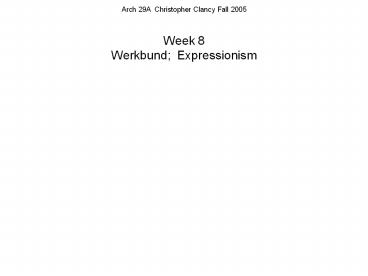Week 8 Werkbund; Expressionism - PowerPoint PPT Presentation
Title:
Week 8 Werkbund; Expressionism
Description:
Title: PowerPoint Presentation Author: User2 Last modified by: Chris Created Date: 8/22/2004 8:37:25 AM Document presentation format: On-screen Show (4:3) – PowerPoint PPT presentation
Number of Views:293
Avg rating:3.0/5.0
Title: Week 8 Werkbund; Expressionism
1
Week 8Werkbund Expressionism
2
Class Logistics
Turn in Take Home Quizzes Discuss Take Home Quiz
Answers Midterm Lecture
3
Werkbund Background
- Germany is unified. 1870
- AEG is formed in Berlin 1883
- Bismarck resigns. 1890.
- The spur of industrialism and Pan-German
nationalism made the Prussian bureaucracy react
against the philistinism of Wilhelmine Germany
and encourage the incipient Arts and Crafts
revival of an intrinsic German Culture. - Peter Behrens appointed principal of Dusseldorf
Kunstgewerbeschule. (art School) 1903.
4
Deutsche Werkbund
- Founded in 1907 by Muthesias, Naumann, and
Schmidt. - Initial membership consisted of 12 independent
artists and twelve craft firms. - The individuals were Peter Behrens, Theodor
Fischer, Josef Hoffmann, Wilhelm Kreis, Max
Leuger, Adelbert Niemeyer, J.M. Olbrich, Bruno
Paul, Richard Riemerschmid, J.J. Scharvolgel,
Paul Schultze-Naumburg, and J.J. Scharvolgel.
5
4 main strands of thought in germany
- Kunstgewerbeschulen direct descendent of arts
and crafts. Belief that quality goods would be
achieved only through a concentration on
handicrafts. - Highly individualistic idea of the role of
artistic invention which held that authentic
forms in architecture could arise only from the
imprint of the expressive temperament. Led to
EXPRESSIONISM. - Materialist and down to earth. The best forms
would be those emerging from the logical and
direct use of new materials to solve building
problems. FUNCTIONALISM - Regarded the functionalist as an uncultivated
brute, the expressionist as an irrelevant remnant
of the cult of genius, the craftsman as an
extinct entity unless directed to the problems of
designing objects for mass production.
6
Hermann Muthesias
- Main proponent of the fourth idea of the previous
slide. - Formed the Werkbund in 1907. From the start it
was seen as being far more than a commercial
matter. Was involved in deep probings into the
nature of the German spirit, the role of form
in industry and the psychic life of the nation. - Borrowed from English Arts and Crafts the idea of
a concern for the moral power of design to
influence peoples lives. - These notions were cross-bred with the ideal of
designing for the machine and with the
philosophical concepts derived from the German
idealist tradition. - The notion that it was the destiny of Germany to
realize some higher idea in the historical scheme
of things.
7
Behrens and AEG
- Behrens was appointed head of the design for AEG
in 1907.
8
Werkbund Jahrbuch magazine
Magazine produced by Werkbund. Praised grain
elevators, etc.
9
Factory for Werkbund
10
Peter Behrens
11
Peter Behrens
Behrens believed that industrial tasks must be
seen as the essential cultural ones of the
time. The factory thus took on a far greater
significance than it had usually possessed.
12
Deutscher Werkbund
13
Peter Behrens - Lamp
14
AEG interior Peter Behrens. 1909
15
AEG Exterior Peter Behrens. 1909
Had the character of a temple dedicated to some
industrial cult. Building needed to be open so
crane could lift unfinished turbines from one end
to other. Behrens was not expressionist, was
seeking a sober, even typical form.
16
Peter Behrens - Lagerhaus
17
1914 Werkbund Exhibition
18
Gropius and Meyer Fagus. 1909
19
Bruno Taut
20
Bruno Taut Glaspavilion. Cologne. 1914
21
Bruno Taut Glaspavilion. Cologne. 1914
22
Bruno Taut Steel Pavilion. Leipzig. 1913
23
Bruno Taut Ledigenheim Clubroom. 1919
24
Nietzschean Origins of Metaphor
The beginning of the use of metaphor in this
century goes back to the early German
Expressionist Architects and had Nietzschean
origins. Architects such as Bruno Taut used to
keep notes in their sketchbooks from Friedrich
Nietzsches Thus Spake Zarathrustra. Nietzsche
described the creative act in terms of ecstatic
revelation. The expressionists and other German
architects created a series of projects evoking
mountain images because Zarathrustra lives in
the perilous solitude of the mountains.
From Poetics of Architecture. Antoniadis
25
Hermann Finsterlin. Concert Hall. 1919
26
Glass Architecture
In order to raise our culture to a higher
level, we are forced, whether we like it or not,
to change our architecture. And this will be
possible only if we free the rooms in which we
live of their enclosed character. This, however,
we can only do by introducing a glass
architecture, which admits the light of the sun,
of the moon, and of the stars into therooms, not
only through a few windows, but through as many
walls as feasible, these to consist entirely of
glass of colored glass. Paul Scheerbart.
Glasarchitektur, 1914
27
Wassily Luckhardt. Crystal on the Sphere. 1920.
28
Wassily Luckhardt. Monument to Joy 1919.
29
Crystal Bruno Taut
30
Crystal Bruno Taut
Bruno taut wrote an allegory called The Glass
Chain in 1919. The coorespondence involved
fourteen people. Apart from Taut, who called
himself glas, there was Gropius (Mass),
Finsterlin (Prometh), and Bruno Tauts brother,
who wrote under his own name. Taut and Scharoun
especially stressed the creative role of the
unconscious.
31
Crystal Peter Behrens.Bookmark Design. 1920
32
Hans Poelzig
33
Hans Poelzig Grosse Schauspielhaus. Berlin. 1919
34
Hans Poelzig Grosse Schauspielhaus. Berlin. 1919
35
Hans Poelzig Sketch. Festspielhaus. 1920
36
Hans Poelzig Light Fixture. 1920
37
Hans Poelzig Water Tower Posen.
38
Hans Poelzig Luban Chemical Plant. 1912
39
Hans Poelzig Church. 1919
40
Rudolf Steiner. Goethaenum. 1913-20
41
Max Taut. Wissinger Family Tomb. 1920
42
Domikus Bohm. St. Johannes Baptist. Neu-Ulm.
1921-26
43
Glaspavilion - Interior
44
Mendelsohn Einstein Tower
45
Mendelsohn Einstein Tower
46
Mendelsohn Train Station. Airport Terminal
47
Hugo Haring
48
Hans Scharoun
49
Berlin Secession Exhibition 1923
50
Hans Scharoun
51
Hans Scharoun . Musikhalle. 1920
52
THE END































